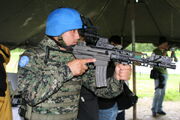The Daewoo K1 is a South Korean carbine developed by Agency for Defense Development (ADD) and manufactured by Daewoo Precision Industries. The weapon entered service in the South Korean Armed Forces in 1981.
Although K1 uses 5.56x45mm NATO, it is classified as a submachine gun by the South Korean military and the current manufacturer S&T Motiv; this is because the K1 was intended to replace M3 submachine gun.
Although similar to the Daewoo K2 rifle, the K1 is mechanically distinct from the K2 and is not merely a carbine version of the K2.
Development[]

A South Korean peacekeeper aiming an upgraded K1A complete with RAS, EO-Tech, laser sight and vertical foregrip.
In 1976, the Republic of Korea Army Special Warfare Command requested a new weapon to replace the old M3 submachine gun. In the following year, ADD launched a project derived from XB rifle, which started in 1972 to replace licensed M16A1s with indigenous weapons. Under the demands of the ROKASWC, the new submachine gun must acquire greater firepower, light weight, cost effectiveness, and easy access to spare parts. The first prototypes were made in 1980, and entered service in 1981 after series of field tests.
However due to the design of its flash suppressor, the K1 exhibited serious problems in service with the ROK armed forces. The original version had excessive recoil, noise, flash, and weak stock due to increase in firepower. These problems caused difficulty in aiming especially during night operation.
These shortcomings were later fixed by the development and adoption of a new flash suppressor, which has three holes in the top right quadrant to limit muzzle flip under rapid fire and reduces flash to one-third of that of the early K1. This new version of K1 is known as the K1A and its production began in 1982. All K1 submachine gun in service were subsequently modified to the K1A standard.
Variants[]
- XK1
Experimental prototype.
- K1
Base variant. All K1 carbines in South Korean service have been modified to the K1A standard.
- K1A
Improved variant.
- MAX-1
Semi-automatic version of K1A for civilian market.
See Also[]
References[]
External Links[]
- Daewoo K1A1: A Hybrid AR-15 and AR-18 - YouTube